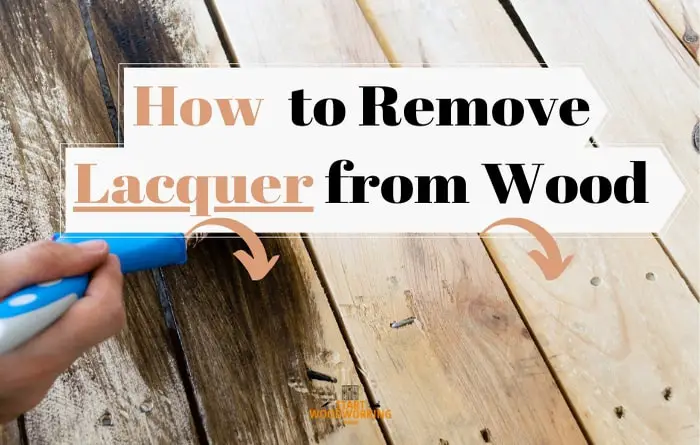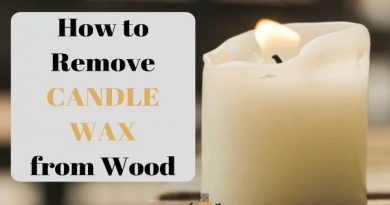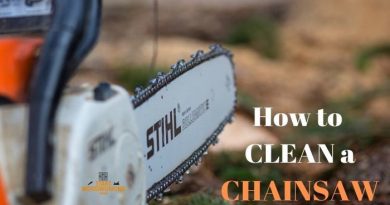How to Remove Lacquer from Wood [In 4 Simple Ways]
If you have to restore a piece of furniture or any wooden object that you have at home, but you don’t know how to remove the lacquer finish correctly, here we tell you how to remove lacquer from wood step by step.
Materials:
- Stripper
- Solvent
- Brush
- Gloves
- Respirator mask
- Spatula
- Sandpaper
- Electrical sander
Steps to remove lacquer from wood:
- First of all, prepare the work surface: place the furniture piece from which you have to remove the lacquer on a table or the floor. Work in a comfortable place, possibly outdoors with good ventilation but without drafts. The dust released when removing the old lacquer finish from the wood is harmful, so you should avoid inhaling them by protecting your airways with a dust mask and also gloves.
- Then remove the hinges and handles if the furniture has them so that you can work without problem.
- The next step is to apply the stripper, which is the product that will allow us to remove the lacquer or varnish, but you must be careful.
- The gel product that you apply over the lacquer may dry out somewhere and then you cannot remove the lacquer, so it is better to work in parts and apply with brush.
- Once you apply the stripper you will see how it will start to work.
- Its action time can vary between 10 and 25 minutes, depending on the surface covered, so you must remove the lacquer finish during that time, with the help of a spatula. For those areas where it is more difficult to reach, use sandpaper.
- When you have finished, you will see that the mixture of the lacquer with the solvent may have left dust or loose debris, so it is better to wipe with a clean cloth soaked in solvent until the wood is clean.
Now you can repaint the furniture or restore it as you wish, but if the wood has several layers of lacquer, you may have to apply more layers of stripper until everything is removed.
If the furniture is very large, it may also be necessary to use a sander to remove the lacquer, which on the other hand, will surely be applied in several layers, so that it applies twice as much stripper as for a small furniture.
| Type of surfaces | Tools to remove lacquer |
|---|---|
| Smooth, stable surfaces (wood, metal, plastic) | Spatula, scraper, electric scraper, mask if necessary |
| Insensitive substrates (stone, metal) | Wire brush, wire brush attachments |
| More sensitive surfaces (wood, metal) | Sandpaper, grinder |
| Hard, water-insensitive substrates (stone) | Pressure washers, sandblasters, protective clothing |
| Heat-resistant substrates (metal, stone) | Heat gun, protective clothing |
| Resistant substrates against paint strippers (variable) | Suitable paint stripper, spatula, protective clothing |
How to Remove Lacquer from Wood by Sanding
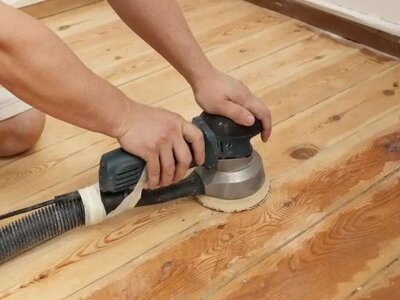
One of the most common ways to remove lacquer from wood is through sanding. It is one of the most common options for removing thin layers of lacquer. Usually, sandpaper is used manually, with a wooden or rubber block, so as not to deform the surface and exert greater pressure on it.
It is first necessary to remove the shiny side conferred by the lacquer. To do this, simply sand your furniture very lightly using medium-grit sandpaper.
Depending on the support to be sanded, you can use a sanding block in which you will insert your sandpaper, or a small sander. There is no need to remove the entire layer of paint and get the wood raw, so no sanding too hard.
The objective of this method is simply to remove this layer of lacquer so that the furniture is no longer slippery and even becomes rough, which will allow the new layer of paint that you will apply later to hang better.
It is recommended to sand by making small circles. Proceed area by area, removing all of the lacquer each time before tackling another area.
For thicker layers, corners and furniture the use of an orbital sander is more recommended. With manual sanders, the work will be done faster and with less physical effort.
For wooden floors or hard surfaces and of less care, the belt sander is used, with which to remove harder materials and remove thicker layers of material, including polishing the wood to renew its color.
Sanding is not recommended for delicate furniture and softwoods, it can scratch the wood too much and cause ripples or damage to edges and trim.
Steps to remove lacquer from wood by sanding:
- Just attach the sandpaper to the special hooks at the base of the sander.
- Hold the appliance with the special support if you pass it on the surface to be stripped without applying any pressure.
- Start with a coarse sandpaper to remove as much material as possible, avoiding deformation in corners and edges.
- Finish with fine sandpaper to polish the wood, and remove traces of paint and scratches caused by the previous pass.
Advantages and disadvantages of removing lacquer from wood by sanding
Keep in mind that sandpaper, especially if you use an electric sander with coarse grit sandpaper, will remove lacquers with relative ease, but if you act on the wood it will leave grooves that will be very difficult to disguise.
I only recommend it if you don’t feel like working a lot and then you’re going to paint over it. And still, with care. It can come in handy when there are multiple layers of paint and you want to save some work.
I also use the sander, with very fine sandpaper (120, 180 onwards) to give a final polished finish, remove traces of paint or varnish that are difficult to remove and always on smooth surfaces.
If the furniture has rounded shapes (tubular legs of a chair, for example) better use manual sandpaper. I confess that sometimes I also use the sander, but I already have some practice and do not touch the rounded shape of the leg.
Another disadvantage is the large amount of dust raised by “amateur” sanders, whether or not they have a deposit to collect the dust.
How to Remove Lacquer from Wood by Chemical Stripping
First and foremost, the selection of the stripper depends on the nature of the lacquer layer to be removed. If several layers of lacquer have to be removed, it is often necessary to repeat the stripping process several times:
| Type of Chemical Stripers | Description |
|---|---|
| Alkaline strippers | Solvent-based strippers have a radical effect on the majority of all paints and lacquers: nitro and acrylic paints, latex paints, and emulsion paints, but also residues of glue or polyurethane (PU) construction foam are loosened and can then be easily removed. |
| Solvent-based strippers | Solvent-based strippers have a radical effect on the majority of all paints and lacquers: nitro and acrylic paints, latex paints, and emulsion paints, but also residues of glue or polyurethane (PU) construction foam are loosened and can then be easily removed. |
Having trouble removing paint from wood? Don’t worry I have created an easy tutorial to help you!
Alkaline strippers
However, care should be taken with veneered wood, there is a risk that treatment with these agents will permanently damage the texture of the veneer.
It is also possible that certain woods containing tannin, such as beech, discolor slightly under the influence of alkaline paint strippers – in this case bleach can help and make the wood tone lighter again.
This product is well known by carpenters and people who are dedicated to DIY, blacksmithing, painting on wooden and metal surfaces mainly.
The lacquer stripper is a chemical that consists of a substance, which is a strong inorganic acid. In fact, it is hydrochloric or sulfuric acid used to remove paint, lacquer, traces of oil, among other elements.
It is not recommended to work it without protection, you should always use it for your good:
- Eye protection.
- Mask with filters for strong chemical odors.
- Use of latex rubber gloves, ideal for chemical products.
Steps to remove lacquer from wood by chemical stripping:
- Remove fittings: Remove the metal fittings before any stripping or grinding treatment. Then the later paintwork will be cleaner and you don’t have to mask anything.
- Sanding the wood: Use an orbital sander and a maximum of 120 grit sandpaper to sand the surface for the lacquer.
- Sanding with steel wool: To sand the lacquer, use a medium-fine steel wool. It adapts to the profile contours better than normal sandpaper.
- Apply paint stripper: Above all, apply a generous amount of paint stripper to fine profiles. Always wear rubber gloves because the paint stripper irritates the skin.
- Paint strippers and brushes: You can get special paint brushes for paint strippers in hardware stores. They have a shaft made of plastic and not metal, which would be attacked by the stripper.
- Sanding off the layer: After stripping, a thin layer of lacquer remains on the wood that you need to sand down. In order to remove the lacquer residue without leaving any residue, you have to sand with 80 sandpaper.
Advantages and disadvantages of the chemical stripper
It is my favorite option for delicate and historical wooden furniture, since, well used, it does not damage the wood, but you have to be very careful with it for several reasons: if you leave drops pouring more than it should, the wood will stain.
It is also the most cumbersome to work with since the remains of lacquer or varnish with the stripping gel make a sticky mass that can be difficult to control.
But if you work carefully and follow some minimal guidelines, it seems to me the best solution. This is how I usually remove lacquer always if later I will leave the wood in its natural color. And this is how I have made these chairs.
How to Remove Lacquer from Wood Using Heat
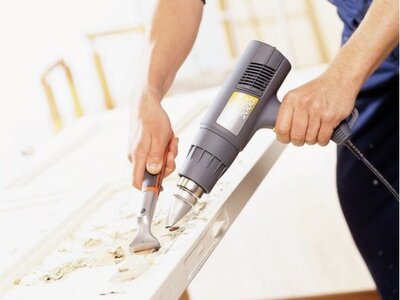
The heat gun removes lacquer, varnish and glue from wood and objects using extremely high temperatures. Varnish and lacquer stains as well as adhesive tape peel off as a result of the strong heat. Use a spatula to help.
Steps to remove lacquer from wood using heat:
- Apply heat on the surface at about 10 to 15 centimeters, and with an inclination of approximately 45 degrees.
- When the lacquer starts to wrinkle, remove it with a putty knife or scraper, being careful not to damage the wood.
- Repeat the process if necessary.
- Finally, sandpaper to remove lacquer residues and smooth the wood surface.
Advantages and disadvantages of removing lacquer using heat
The advantage of removing lacquer from wood using heat is that it hardly stains, it does not have any chemical agent, so it does not pollute and it is also a relatively fast process. From my experience, you have to work with agility and precision, as the lacquer quickly solidifies again.
In addition, you must be careful not to scratch the wood with the spatula, scriber or nozzle of the gun when removing it. Finally, be careful with the temperature when using it: we do not want to burn or darken the wood. The temperature is really high. The best thing, if you have a heat blower, is to test it.
How to Remove Lacquer from Wood with a Spatula
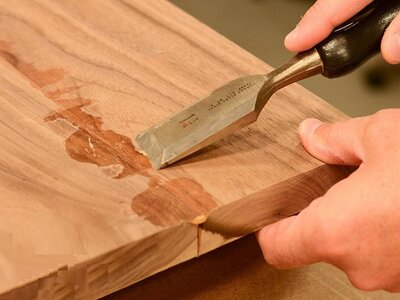
With the spatula or scraper, you can remove old lacquer finish, varnish, or other residues such as glue and tape from smooth and stable surfaces made of wood, plastic and metal.
Various spatulas and scrapers are available for this purpose: flexible, rounded, pointed, or sharp-edged as well as various sizes. Remove paint residue or tape with the hand tool as carefully as possible.
Steps to remove lacquer from wood with a spatula:
- Bring the appropriate spatula or scraper lightly to the area from below and vigorously scrape off the lacquer or lacquer residues with vertical movements.
- Then repeat the work in a horizontal position.
- Finally, remove any remaining lacquer finish with a sponge.
You can use an electric scraper to work on larger areas or to remove stubborn lacquer and varnish residues. Many multifunctional devices also have a scraper function and corresponding attachments.
Conclusions
If the surface from which you want to remove the lacquer already has several layers of paint, it is best to use sandpaper as your ally, since you will obtain a smoother and more uniform surface to repaint and obtain better finishes.
Learning how to remove lacquer from wood takes time so it is important to practice on the wood areas that are least visible. Try to do it in ventilated areas or outdoors, since dust and fumes can be harmful to the respiratory tract.
Regardless of what kind of method you want to choose when removing lacquer from wood, we wish you a quick and successful work. Please also keep in mind that removing lacquer can put a lot of stress on the wood. It is therefore advisable to subsequently treat the wood with a high-quality wood oil or a deep regenerating wood glaze.
Alcohol with higher concentration is functional in the process of removing the lacquer, as long as you do not have other options mentioned in the post. Because alcohol is very volatile and flammable, on the other hand, it is expensive and requires its application more times than with a stripper.
All sanders serve one purpose and that is to work abrasively against the surface of the wood. Therefore, you can choose between Band, Orbital, and for difficult corners and spaces the Delta.
Once the products act, use a spatula gently to remove traces of varnish and, surely, some remains will remain. Apply a sandpaper for medium-weight wood and voila, you can do what you want with that piece of furniture.

